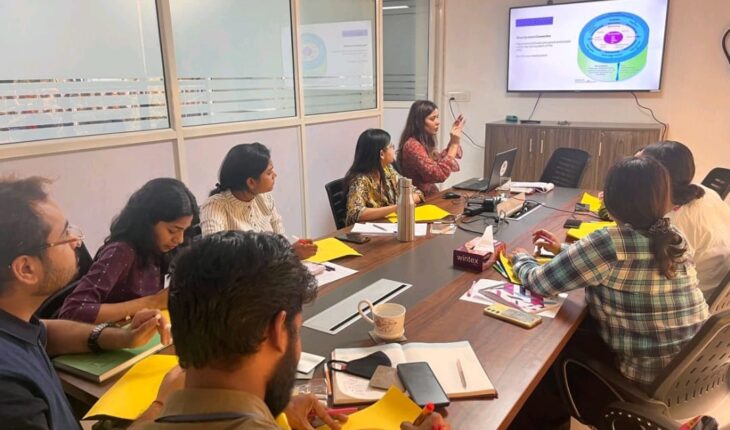By Garima Goswamy and Prakriti Pandia :
In Today’s rapidly evolving technological landscape, the imperative to adapt and grow professionally is universal.
For security professionals, this demand for continuous development is particularly acute. There is a huge skill gap particularly in cyber security, which is more in demand within the security domain. As per 2022 Cybersecurity Skills Gap Report published by Fortinet (a cybersecurity company), skill shortage in cyber security amounts to 80% of breaches. As per a study conducted by TeamLease, a tech staffing firm, as of May 2023, cyber security had 40,000 open opportunities but the demand and supply gap stood at 30%. Some constructive steps are being taken. For instance, since 2020, Central Investigation and Security Services Limited (CISS) has trained at least 2,000 personnel in corporate and security management, command center operations, capacity building for security executives, and hands on training for dog handlers. This is part of a memorandum of understanding between CISS group of companies and Rastriya Raksha University. On similar lines, to fulfil the requisite training and awareness requirements in physical security, companies like DridhG Security International Private Limited is also in talks with prominent institutes.

Hurdles :- Given the fast pace in which technological advancement is taking place, there is a need to update and upgrade Oneself. The security professional is no different. However, in India, there are various challenges faced by organizations to provide the kind of platform that is required for knowledge enhancement. Usually those in decision making position ask for a valid reason for investing in programs pertaining to training and development from operations’ heads. Very few are able to present a case to their management. At times, even after recognizing the requirement, there are roadblocks. More often than ever, the reason for not investing in training and awareness sessions is claimed to be budget constraint. Once budget allocation is done, the next task is to look for an efficient trainer. This process of identifying the training needs, getting the necessary approval for conducting the requisite training and awareness sessions, search and the process of shortlisting of qualified external trainers, and setting up a training calendar becomes a lengthy process in some organizations. Then again, there are some other factors which also act like a very big hurdle. We opine that not many companies have a good culture of training and awareness because there is a very deep-rooted insecurity. Many managers think “If I train my team, what if they supersede me?” So, a lot of people do not wish to engage in training and awareness not because of budget constrain or time constrain, but because there is an insecurity that a youngster might just supersede and what will happen to the legacy of those who have been in the system for quite some time. In training and awareness also, there is a need of what Immanuel Kant used to call “goodwill” which can be loosely understood as “doing good for the sake of goodness.” Training and awareness sessions should be conducted for the sake of training and awareness, that is, for knowledge enhancement. Training and awareness sessions should be conducted in a process-oriented way, letting go of the subjective thoughts of managers or even senior leadership. There should be a realization that it is being done for the overall good of the company by enhancing the quality of professionals working in the organization.
How do Training and Awareness Sessions Help in Creating Psychological Safety ?
Psychological safety can be understood as feeling safe to take inter personal risks – to speak up, to disagree if needed, to share concerns without the fear of retaliation or facing negative consequences. To understand the role of Training and Awareness (T&A) in fostering psychological safety, we must dissect it into two components: the impact of T&A sessions and the dynamics of group sessions on mental wellness.
1. In training and awareness sessions, since the goal is knowledge sharing and knowledge enhancement, a safe place is provided for participants to exchange ideas, brainstorm, share their understanding (on the topic of discussion) and cultivate interests. After an efficient T&A session, they go back better informed. Such a session gives a lot of food for thought as a key takeaway and it encourages participants to research about the topic and engage with the subject long after the session is over.
2. Regrettably, the Indian education system often neglects the development of effective interpersonal communication skills. We advocate for the inclusion of mandatory group sessions led by mental health professionals, addressing concerns related to psychological safety and interpersonal communication. This equips employees with vital tools for self-awareness, enabling them to navigate interpersonal interactions adeptly. When individuals comprehend their coping mechanisms, they respond more constructively, fostering a conducive environment for open communication, conflict resolution, and mutual respect of boundaries—essential elements for upholding psychological safety within any organization.
Useful Tools : For a successful or efficient training and awareness session, engagement is extremely important. Simply trying to interact by asking questions might not always work as some participants shy away, and some are just not interested.
Conducting a table top exercise conducted on groups is an effective tool. It is always a good idea to add a little competition between teams. It ensures participation – even by those who like to stay in the background. For online self-paced training, a module which does not allow you to move ahead unless you complete a task is also an effective tool. Even those participants who join the session to tick a box or to get a certificate are forced to participate and put their thinking caps on to complete the T&A session.
By transcending logistical challenges, nurturing psychological safety, and employing engaging tools, organisations can fortify their physical security infrastructure. This holistic approach not only bolsters the competency of their workforce but also lays the foundation for a culture of continuous improvement and adaptability, essential attributes in an ever-evolving security landscape. Conclusion : In conclusion, the integration of comprehensive training and awareness programs in physical security not only addresses logistical hurdles but also profoundly influences the psychological safety of individuals within an organization. By fostering an environment of psychological safety, where individuals feel secure to voice their concerns and engage in open communication, organizations can cultivate a culture of trust, collaboration, and mutual respect. It creates a trauma-informed space. This, in turn, leads to enhanced job satisfaction, reduced stress levels, and increased overall well-being. Moreover, the utilization of engaging tools, such as interactive modules and dynamic team exercises, maximizes the efficacy of these programs, ensuring active participation and knowledge retention. Ultimately, an organization that prioritizes its workforce’s cognitive and emotional dimensions stands poised to fortify its physical security measures and nurture a resilient and adaptive organizational culture.
Disclaimer: The information in this report is gathered from open sources available in the public domain. The purpose is solely to spread awareness. However, any discretion or choice or action taken upon reading this report is entirely the reader’s prerogative not our responsibility. We are not responsible or liable to any such action.





